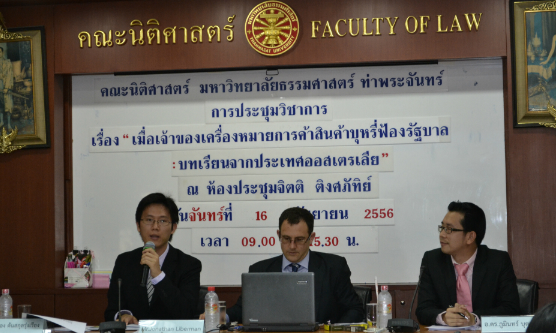I had the great privilege of being in Bangkok, Thailand, last week to talk with public health and legal colleagues about Thailand's defence of lawsuits brought against it by the multinational tobacco industry.
The reason for my second visit was not a pleasant one, but one that is becoming increasingly common in the battle between public health and the global tobacco industry. Thailand recently enacted regulations to increase the size of graphic health warnings from 55% to 85% of the front and back of tobacco packaging. While Thailand, a country with a population of approximately 65 million, has made significant progress in reducing smoking rates over the last two decades, over 40% of males over the age of 15 still smoke.
Of course, the major tobacco multinationals (Japan Tobacco, Philip Morris and British American Tobacco) responded by doing what their DNA evidently demands of them - suing. The Thai Central Administrative Court has
suspended enforcement of the new regulations, which were due to commence on 2 October, pending determination of the industry's claim. The Thai Government is appealing against the suspension.
 Khemthong Tonsakulrungruang, Jonathan Liberman and Dr.Bhumindr Butr-indr at Thammasat Law School
Khemthong Tonsakulrungruang, Jonathan Liberman and Dr.Bhumindr Butr-indr at Thammasat Law School
Among its many achievements, the FCTC has engendered a globalization of tobacco control networks, enabling us to share experiences and insights, and learn from one another in our individual and collective battles against the tobacco industry.
What can Thailand learn from Australia's experience, I was asked. The Thai regulations are different from the Australian legislation in several ways, including that Australia's plain packaging law prohibits the display of logos, brand imagery, symbols, other images, colours or promotional text on tobacco product packaging, and mandates that packaging be a standard drab dark brown colour and that graphic health warnings occupy 75% of the front and 90% of the back of packaging. The Thai regulations allow tobacco brand imagery and colours, but confine them to 15% of the front and back, as well as the top and bottom, of packaging.
While the two countries' packaging laws and constitutions are different, many of the tobacco industry's legal arguments in its challenge to Thailand's regulations are familiar. A number are in essence a cry to ‘keep your regulatory hands off our intellectual property rights', primarily trademarks.
In
a recent paper, I suggested that six narratives or themes could be discerned in the five judgments that constituted the 6-1 majority in the Australian High Court:
- That the relevant intellectual property rights of the tobacco companies were ‘negative rights', i.e. rights to exclude others from using their property, rather than positive rights to use it themselves.
- That tobacco companies may have lost something of commercial value, but commercial value is not the object of constitutional protection. I think of this as the ‘so what?' response. Yes, we are trying to reduce the number of lethal, addictive products you sell in order to reduce the amount of harm you do, and if your profits suffer as a result, well, that's life.
- That the regulatory scheme is no different in kind from other legislation requiring health or safety warnings.
- That the requirements of the scheme are conditions on the sale of tobacco products. The Government does not itself use tobacco packaging. If you choose to market these products - and no one is making you do so - these are the conditions you must comply with.
- That the scheme allows the continued use of brand names (including trademarked brand names), and the ability to use such names is valuable - i.e. Marlboro is still Marlboro, with or without the chevron.
- That intellectual property rights are created to serve public purposes, but they are not sacrosanct, and they do not operate above or in isolation from other laws created to serve other public purposes. The fact that you may have intellectual property rights does not prevent the Government from restricting your exploitation of those rights in order to serve the public interest.
While these narratives and themes will be presented in different ways, and using different legal concepts, in different constitutional contexts, I think they are useful generally to cases about plain packaging and large graphic health warnings.
There is another important lesson from the Australian case - that the fact that the tobacco industry claims that something is unlawful does not mean it is. And by extension, that governments cannot afford to be cowered by its threats.
One memorable BAT media release titled
‘Plain packaging now heads to High Court'claimed that ‘the result of BAT's legal challenges could force [the Australian Government] to pay tobacco companies billions of dollars'. This was always a lie, because even if BAT had won, the Australian Government would not have had to pay billions of dollars in compensation. Rather, Australia would not have ended up with plain packaging. That's the way the relevant constitutional provision works.
BAT also claimed that ‘it is no secret that legal experts believe the Federal Government is on shaky legal ground with plain packaging'. In truth, it was exceedingly difficult to find someone who was both a lawyer and not on the tobacco industry's payroll who thought the industry was going to win. And so it proved - a 6-1 victory to the Government, and costs awarded against the tobacco industry.
Perhaps I should give the last word to a Thai doctor I met last week, one of the many dedicated and committed advocates trying to reduce the damage the tobacco industry is inflicting on their country. He asked, ‘Why does the tobacco industry always talk about its intellectual property rights, and never about the people who die from using its products?'



